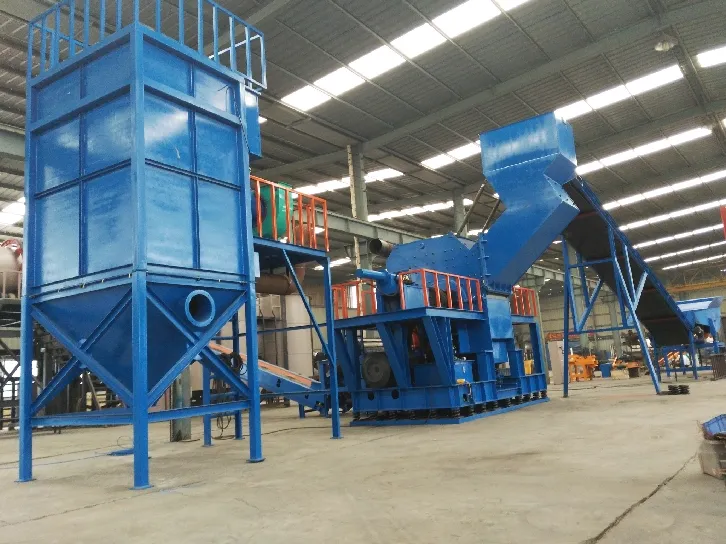

Окт . 22, 2024 10:17 Back to list
Eddy Current Separator Design Principles and Applications
Eddy current separators (ECS) are sophisticated devices used in recycling and mining industries to separate non-ferrous metals from bulk materials. They operate on the principle of electromagnetic induction, utilizing the unique characteristics of conductive materials. Designing an effective eddy current separator involves understanding the core principles of physics, material properties, and operational efficiencies.
Principles of Operation
The working principle of an eddy current separator is based on the production of eddy currents in conductive materials when they are exposed to a changing magnetic field. When a non-ferrous metal, such as aluminum or copper, passes over a rotating magnetic drum, the magnetic field induces circular electric currents—known as eddy currents—within the metal. These currents generate their own magnetic field, which interacts with the external magnetic field provided by the separator.
As the eddy currents create a repulsive force, the non-ferrous metals are propelled away from the conveyor belt, while non-metal materials continue to move downward due to gravity. This separation process effectively removes unwanted metal contaminants from recyclable materials, such as plastic, rubber, or wood, enhancing the purity of recovered materials.
Key Design Considerations
1. Magnetic System Design The magnetic configuration plays a critical role in the efficiency of an eddy current separator. Using high-performance permanent magnets or electromagnetic coils optimizes the strength and direction of the magnetic field. The design must ensure a balanced field that maximizes the generation of eddy currents while minimizing energy consumption.
2. Drum Size and Design The diameter and length of the magnetic drum significantly influence the separator's performance. A larger drum can cover a greater separation area and process larger volumes of material, but it may also require more powerful magnetic sources. Consequently, the drum design must strike a balance between size, power requirements, and material throughput.
3. Conveyor System The type and speed of the conveyor belt are crucial for effective separation. The belt must be designed to handle varying material sizes and weights and maintain a consistent flow rate to ensure optimal interaction with the magnetic field. Choosing the right belt material also ensures durability and resistance to wear and tear.

4. Material Feed Control Controlling the feed rate of the materials entering the eddy current separator is essential for achieving consistent separation performance. Inadequate control can lead to blockages or inefficient metal recovery. Incorporating sensors and automated feed mechanisms can enhance operational efficiency and reduce manual intervention.
5. Fines Removal Smaller particles or fines can adversely affect the performance of an ECS if they clog or hinder the separation process. Design considerations should include mechanisms for managing fines, such as air classifiers or screening systems that ensure the effective removal of these smaller unwanted materials.
Applications of Eddy Current Separators
Eddy current separators are widely used across various industries due to their efficiency and reliability.
- Recycling ECS plays an essential role in the recycling of metals, particularly in facilities handling mixed waste streams. They effectively recover aluminum cans, copper wires, and other valuable metals that would otherwise be lost in the recycling process.
- Mining In the mining sector, eddy current separators are employed to extract valuable non-ferrous metals from tailings or waste streams, contributing to resource recovery and sustainable mining practices.
- Construction and Demolition ECS systems are increasingly being used in the processing of construction and demolition debris to isolate metal scraps from other materials, facilitating efficient recycling in this sector.
In conclusion, the design of eddy current separators is a complex interplay of physics, engineering, and material science. By focusing on optimized magnetic systems, effective material handling, and operational control, these devices greatly improve the efficiency of metal recovery processes across various applications. As industries continue to seek sustainable solutions, eddy current separators will undoubtedly play an essential role in advancing recycling and resource recovery efforts.
Latest news
Troubleshooting Common Eddy Separator Problems
NewsJul.04,2025
The Role of Metal Recycling Plants in Circular Economy
NewsJul.04,2025
The Impact of Recycling Line Pickers on Waste Management Costs
NewsJul.04,2025
Safety Features Every Metal Shredder Should Have
NewsJul.04,2025
How Industrial Shredders Improve Waste Management Systems
NewsJul.04,2025
How Cable Granulators Contribute to Sustainable Recycling
NewsJul.04,2025